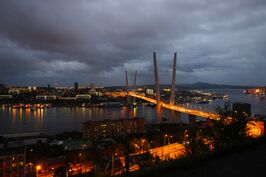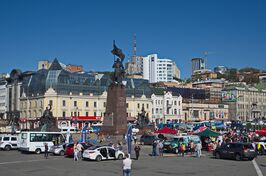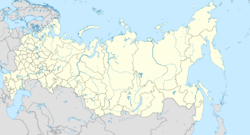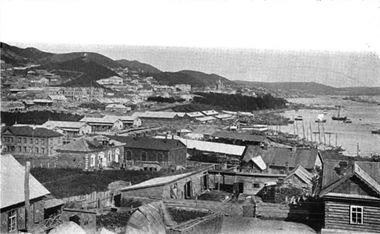ڤلاديڤوستوك
{{ safesubst:#invoke:Unsubst||date=__DATE__|$B=
ڤلاديڤوستوك
Владивосток | |
|---|---|
| الترجمة اللفظية بالـ Other | |
Top-down, left-to-right: View of Zolotoy Bridge and the Golden Horn Bay at night, with the Russky Bridge in the distance; GUM Department Store; Vladimir K. Arseniev Museum of Far East History; the campus of Far Eastern Federal University; Vladivostok Railway Station; and Central Square | |
| الإحداثيات: 43°08′N 131°54′E / 43.133°N 131.900°E | |
| البلد | روسيا |
| الكيان الاتحادي | Primorsky Krai[1] |
| Founded | 2 July 1860[2] |
| مدينة status since | 22 أبريل 1880 |
| الحكومة | |
| • الكيان | City Duma |
| • الرئيس | Konstantin Shestakov[3][4] |
| المساحة | |
| • الإجمالي | 331٫16 كم² (127٫86 ميل²) |
| المنسوب | 8 m (26 ft) |
| التعداد | |
| • Estimate (2018) | 604٬901 |
| • الترتيب | رقم 22 in 2010 |
| • Subordinated to | ڤلاديڤوستك مدينة خاضعة لولاية الكراي القضائية[1] |
| • Capital of | كراي پريمورسكي[6], ڤلاديڤوستك مدينة خاضعة لولاية الكراي القضائية[1] |
| • Urban okrug | أوكروگ ڤلاديڤوستكسكي الحضري[7] |
| • Capital of | أوكروگ ڤلاديڤوستكسكي الحضري[7] |
| منطقة التوقيت | UTC+ ([8]) |
| Postal code(s)[9] | 690xxx |
| Dialing code(s) | +7 423[10] |
| OKTMO ID | 05701000001 |
| مدينة Day | أول أحد من يوليو |
| الموقع الإلكتروني | www |
ڤلاديڤوستوك (روسية: Владивосто́к; النطق الروسي: [vlədʲɪvɐˈstok] (![]() استمع)، وتعني حرفياً 'حاكم الشرق'، إنگليزية: Vladivostok) هي أهم مرفأ في روسيا الاتحادية على المحيط الهادي. تقع فلاديفوستوك في الجنوب الشرقي من سيبريا قرب الحدود الكورية. يبلغ عدد سكانها 643,000 نسمة.
استمع)، وتعني حرفياً 'حاكم الشرق'، إنگليزية: Vladivostok) هي أهم مرفأ في روسيا الاتحادية على المحيط الهادي. تقع فلاديفوستوك في الجنوب الشرقي من سيبريا قرب الحدود الكورية. يبلغ عدد سكانها 643,000 نسمة.
تبلغ مساحة ميناء ڤلاديڤوستك نحو 5 كم². ويتجمد المرفأ عادة بين شهري يناير ومارس، فتُستخدم كاسحات الجليد للحفاظ عليه مفتوحًا. ويعتبر ميناء ڤلاديڤوستك قاعدة لأساطيل الصيد. وتوجد بالمدينة مرافئ لبناء وترميم السفن. وفي مدينة ڤلاديڤوستك الكثير من مصانع التعليب. كما أنها تنتج معدات التعدين. وتقع ڤلاديڤوستك قرب نهاية خط السكة الحديدية الذي يعبر سيبريا. وكان الروس قد أسسوها عام 1860، وأصبحت قاعدة للبحرية بعد أن فقدت روسيا لوشون (كانت تسمى أيضًا پورت آرثر) حين ضمتها اليابان عام 1905. واليوم يستخدم جزء كبير من الأسطول التجاري الروسي ميناء ڤلاديڤوستك .
Shortly after the signing of the Treaty of Aigun between Qing China and the Russian Empire and affirmed by the Convention of Peking – of which it is also known as the Amur Annexation – the city was founded as a Russian military outpost on July 2, 1860.[11] In 1872, the main Russian naval base on the Pacific Ocean was transferred to the city, stimulating its growth. After the outbreak of the Russian Revolution in 1917, Vladivostok was occupied in 1918 by White Russian and Allied forces, the last of whom from the Japanese Empire were not withdrawn until 1922 due to its wider intervention in Siberia; by that time the antirevolutionary White Army forces had promptly collapsed. That same year, the Red Army occupied the city, absorbing the Far Eastern Republic into the Russian Soviet Federative Socialist Republic. Following the dissolution of the Soviet Union in 1991, the city became a part of the Russian Federation.
Today, Vladivostok remains the largest Russian port on the Pacific Ocean, and the chief cultural, economic, scientific, and tourism hub of the Russian Far East. As the terminus of the Trans-Siberian Railway, the city was visited by over three million tourists in 2017.[12] The city is the administrative center of the Far Eastern Federal District, and is the home to the headquarters of the Pacific Fleet of the Russian Navy. Due to its geographical position to Asia combined with its Russian architecture, the city has been referred to as "Europe in the Far East".[13][14] Many foreign consulates and businesses have offices in Vladivostok, and the city hosts the annual Eastern Economic Forum. With a yearly mean temperature of around 5 °C (41 °F) Vladivostok has a cold climate for its mid-latitude coastal setting. This is due to winds from the vast Eurasian landmass in winter, also cooling the ocean temperatures.
المدينة هي مقر أسطول الهادي الروسي وهو أكبر ميناء روسي على ساحل المحيط الهادي.
الأسماء وأصولها
سُميت ڤلاديڤوستك لأول مرة عام 1859 مع تضاريس أخرى في منطقة خليج پطرس الأكبر بواسطة نيقولاي موراڤيوڤ-أمورسكي. أُطلق الاسم لأول مرة على الخليج، في أعقاب تجريدة الكسي شفنر عام 1860، طُبق على المستوطنة الجديدة.[15]
في اللغة الصينية، كان المكان حيث تقع المدينة اليوم يُعرف منذ عهد أسرة مينگ باسم هايشنواي (海參崴، Hǎishēnwǎi)، من المانچو Haišenwai (المانچو: ᡥᠠᡳᡧᡝᠨᠸᡝᡳ; Möllendorff: Haišenwai; Abkai: Haixenwai) أو "القرية الساحلية الصغيرة".[16]
في الصين المعاصرة، تُعرف ڤلاديڤوستوك رسمياً باسم 符拉迪沃斯托克 (Fúlādíwòsītuōkè)، بالرغم من أن الاسم الصيني التاريخي 海參崴 (Hǎishēnwǎi) لا زال يستخدم في الكتابات الشائعة وخارج البر الرئيسي للصين للإشارة إلى المدينة.[17][18] وفقًا لأحكام الحكومة الصينية، ينبغي أن تضع جميع الخرائط المنشورة في الصين اسم المدينة الصيني بين قوسين.[19]
الاسم الياباني الحديث للمدينة يُكتب Urajiosutoku (ウラジオストク). تاريخياً، كان اسم المدينة يكتب بلغة كانجي: 浦塩斯徳ويُختصر Urajio ウラジオ; 浦塩.[20]
التاريخ
التأسيس
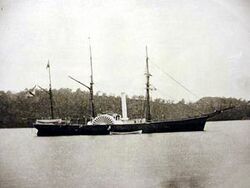 الحراقة-الباخرة أمريكا في خليج القرن الذهبي |
السكان الأصليون للأراضي التي تقع عليها ڤلاديڤوستوك الحديثة هم أقلية الأودگ، وأقلية فرعية تسمى تاز التي ظهرت من خلال جماعات الأودگ الأصليين الذين اختلطوا مع المناطق المجاورة الصينية وهژه. كانت المنطقة جزءًا من العديد من الدويلات، مثل موهى ومملكة بالهاى، أسرة لياو، أسرة جين، أسرة يوان، أسرة مينگ، أسرة تشنگ، ومختلف الأسرات الصينية الأخرى، قبل أن تستحوذ روسيا على المنطقة البحرية بأكملها وجزيرة سخالين بموجب معاهدة بكين (1860). صين تشنگ، التي خسرت للتو حرب الأفيون مع بريطانيا، لم تتمكن من الدفاع عن المنطقة. قام أباطرة الصين المانچو، أسرة تشنگ، بمنع الهان الصينيين من معظم منشوريا بما في ذلك منطقة ڤلاديڤوستوك (انظر Willow Palisade) - وكان يزورها فقط جامعو الجنسنگ وخيار البحر الغير قانونيين.
في 20 يونيو 1860 (2 يوليو (بالتقويم الگريگوري)، وصلت سفينة الإمدادات العسكرية منچور تحت قيادة الكابتن ألكسي ك. شفنر، إلى خليج القرن الذهبي لتأسيس قاعدة في ڤلاديڤوستوك. وصل رقيب أول نيقولاي كوماروڤ برفقة 28 جندي وضابطين صف تحت قيادته قادمين من نيقولايسك-على-الآمور على متن سفينة لإنشاء أول مباني في المدينة المستقبلية.
التاريخ المبكر
كانت حرب مانزا عام 1868 أول محاولة روسية لطرد الصينيين من المنطقة الواقعة تحت سيطرتهم. اندلعت الأعمال العدائية حول ڤلاديڤوستوك عندما حاول الروس إغلاق عمليات التعدين عن الذهب وطرد العمال الصينيين من هناك.[21] قاوم الصينيون محاولة روسية الاستيلاء على جزيرة أشولد، ورداً على ذلك، هاجم الصينيون مركزين عسكريين روسيين وثلاث بلدات روسية وأخفق الروس في دحرهم.[22]
تم تشييد نظام تحصينات متقن بين أوائل سبعينيات القرن التاسع عشر وأواخر تسعينيات القرن التاسع عشر. تم افتتاح خط تلغراف من ڤلاديڤوستوك إلى شنغهاي وناگاساكي في عام 1871. وفي نفس العام تم نقل الميناء التجاري من نيقولاييڤسك-أون-أمور إلى ڤلاديڤوستوك. مُحنت وضع البلدة في 22 أبريل 1880. اعتمد شعار النبالة، الذي يمثل النمر السيبيري، في مارس 1883. ُ أُفتتحت أول مدرسة ثانوية في المدينة عام 1899. وعام 1916 شهد اقتصاد المدينة دفعة باكتمال السكك الحديدية عبر سبيريا، التي تصل ڤلاديڤوستوك بموسكو وأوروپا.[23]
الحرب العالمية الأولى والحرب الأهلية الروسية
During World War I, no active hostilities took place in the city.[24] However, Vladivostok was an important staging post for the import of military-technical equipment for troops from allied and neutral countries, as well as raw materials and equipment for industry.[25]
Immediately after the October Revolution in 1917, during which the Bolsheviks came to power, the Decree on Peace was announced, and as a result of the Treaty of Brest-Litovsk concluded between the Bolshevik government of Russia and the Central Powers, led to the end of Soviet Russia's participation in World War I. On October 30, the sailors of the Siberian Military Flotilla decided to "rally around the united power of the Soviets", and the power of Vladivostok, as well as all of the Trans-Siberian Railway passed to the Bolsheviks.[24] During the Russian Civil War, from May 1918,[26] they lost control of the city to the White Army-allied Czechoslovak Legion, who declared the city to be an Allied protectorate. Vladivostok became the staging point for the Allies' Siberian intervention, a multi-national force including Japan, the United States and China; China sent forces to protect the local Chinese community after appeals from Chinese merchants.[27] The intervention ended in the wake of the collapse of the White Army and regime in 1919; all Allied forces except the Japanese withdrew by the end of 1920.[24]

Throughout 1919 the region was engulfed in a partisan war.[24] To avoid a war with Japan, with the filing of the Soviet leadership, the Far Eastern Republic, a Soviet-backed buffer state between Soviet Russia and Japan, was proclaimed on 6 April 1920. The Soviet government officially recognized the new republic in May, but in Primorye a riot occurred, where significant forces of the White Movement were located, leading to the creation of the Provisional Priamurye Government, with Vladivostok as its capital.[28]
In October 1922, the troops of the Red Army of the Far Eastern Republic under the command of Ieronim Uborevich occupied Vladivostok, displacing the White Army formations from it. In November, the Far Eastern Republic liquidated and became a part of Soviet Russia.[29]
العصر السوڤيتي
By the time of the establishment of Soviet power, Vladivostok was clearly in decline. The retreating forces of the Imperial Japanese Army (IJA) removed items of material value from the city. Life was paralyzed; there was no money in the banks, and the equipment of enterprise was plundered. Due to mass migration and repression, the city's population decreased to 106,000 inhabitants.[30] Between 1923 and 1925, the government adopted a "three-year restoration" plan, during which operations at the commercial port were resumed, and it became the most profitable in the country (from 1924 to 1925).[30][31] The "restoration" period was distinguished by a number of peculiarities: the Russian Far East did not adopt 'war communism', but was, immediately, inducted to the New Economic Policy.[31]
In 1925, the government decided to accelerate the industrialization of the country. A number of subsequent "five-year plans" changed the face of Primorye, making it an industrial region, partly as a result of the creation of numerous concentration camps in the region.[31] In the 1930s and 1940s, Vladivostok served as a transit point on the route used to deliver prisoners and cargo for the Sevvostlag of the Soviet super-trust Dalstroy. The notorious Vladivostok transit camp was located in the city. In addition, in the late 1930s and early 1940s, the Vladivostok forced labour camp (Vladlag) was located in the area of the Vtoraya Rechka railway station.[32]
Vladivostok was not a place of hostilities during the Great Patriotic War, although there was a constant threat of attack from Japan. In the city, a "Defense Fund" was created (the first in the country), to which the residents of Vladivostok contributed personal wealth.[33] During the war years Vladivostok handled imported cargo (lend-lease) of a volume almost four times more than Murmansk and almost five times more than Arkhangelsk.[34]
By the decree of the Council of Ministers of the Soviet Union "Issues of the Fifth Navy" dated August 11, 1951, a special regime was introduced in Vladivostok (it began to operate on January 1, 1952); the city was closed to foreigners.[35] It was planned to remove from Vladivostok not only foreign consulates, but also the merchant and fish fleet and transfer all regional authorities to Voroshilov (now Ussuriysk). However, these plans were not implemented.[35]
During the years of the Khrushchev Thaw, Vladivostok received special attention from state authorities. In 1954, Nikita Khrushchev visited the city for the first time to finally decide whether to secure the status of a closed naval base for him.[36] It was noted that at that time the urban infrastructure was in a deplorable state.[36] In 1959, Khrushchev visited the city again. The result is a decision on the accelerated development of the city, which was formalized by the decree of the Council of Ministers of the Soviet Union on 18 January 1960.[36] During the 1960s, a new tram line was built, a trolleybus was launched, the city became a huge construction site: residential neighborhoods were being erected on the outskirts, and new buildings for public and civil purposes were erected in the center.[36]
In 1974, Gerald Ford paid an official visit to Vladivostok, to meet with Leonid Brezhnev, becoming the first President of the United States to visit the Soviet Union.[37]
On September 20, 1991, Boris Yeltsin signed decree No. 123 "On the opening of Vladivostok for visiting by foreign citizens", which entered into force on January 1, 1992, ending Vladivostok's status as a closed city.[38]
العصر الحديث
In 2012, Vladivostok hosted the 24th APEC summit. Leaders from the APEC member countries met at Russky Island, off the coast of Vladivostok.[39] With the summit on Russky Island, the government and private businesses inaugurated resorts, dinner and entertainment facilities, in addition to the renovation and upgrading of Vladivostok International Airport.[40] Two giant cable-stayed bridges were built in preparation for the summit, the Zolotoy Rog bridge over the Zolotoy Rog Bay in the center of the city, and the Russky Island Bridge from the mainland to Russky Island (the longest cable-stayed bridge in the world). The new campus of Far Eastern Federal University was completed on Russky Island in 2012.[41]
In December 2018, the seat of the Far Eastern Federal District, established in May 2000, was moved from Khabarovsk to Vladivostok.[42]
الجغرافيا
The city is located in the southern extremity of Muravyov-Amursky Peninsula, which is about 30 كيلومتر (19 mi) long and 12 كيلومتر (7.5 mi) wide.
The highest point is Mount Kholodilnik, 257 متر (843 ft). Eagle's Nest Hill is often called the highest point of the city; but, with a height of only 199 متر (653 ft), or 214 متر (702 ft) according to other sources, it is the highest point of the downtown area, but not of the whole city.

Located in the extreme South East of Asian Russia, Vladivostok is geographically closer to Anchorage, Alaska and even Darwin, Australia than it is to the nation's capital of Moscow. In fact, Vladivostok is closer to Honolulu, Hawaii than to the Russian city of Sochi.
الطقس
- المتوسط السنوي لدرجة الحرارة: 4٫3 °C (39٫7 °F)
- Average temperature in January: −13٫7 °C (7٫3 °F)
- Average temperature in August: 20٫2 °C (68٫4 °F)
- Average annual precipitation: 722 mm (strong summer maximum)
- تصنيف كوپن للمناخ: Dwb (monsoon-influenced humid continental climate, warm summers)
| متوسطات الطقس لڤلاديڤوستوك | |||||||||||||
|---|---|---|---|---|---|---|---|---|---|---|---|---|---|
| شهر | يناير | فبراير | مارس | أبريل | مايو | يونيو | يوليو | أغسطس | سبتمبر | اكتوبر | نوفمبر | ديسمبر | السنة |
| العظمى القياسية °C (°F) | 5.0 (41) | 9.9 (50) | 15.2 (59) | 22.7 (73) | 29.5 (85) | 31.8 (89) | 33.6 (92) | 33.0 (91) | 30.0 (86) | 23.4 (74) | 17.5 (64) | 19.3 (67) | 33٫6 (92) |
| متوسط العظمى °م (°ف) | -9.3 (15) | -5.9 (21) | 1.2 (34) | 8.8 (48) | 14.2 (58) | 17.0 (63) | 21.1 (70) | 23.3 (74) | 19.6 (67) | 12.9 (55) | 2.9 (37) | -5.9 (21) | 8٫4 (47) |
| متوسط الصغرى °م (°ف) | -17.1 (1) | -14.0 (7) | -6.1 (21) | 1.2 (34) | 6.2 (43) | 10.6 (51) | 15.6 (60) | 17.8 (64) | 13.0 (55) | 5.7 (42) | -4.1 (25) | -13.0 (9) | 1٫4 (35) |
| الصغرى القياسية °م (°F) | -31.4 (-25) | -28.9 (-20) | -22.0 (-8) | -8.1 (17) | -0.8 (31) | 3.7 (39) | 8.8 (48) | 10.1 (50) | 2.2 (36) | -9.7 (15) | -23.0 (-9) | -28.1 (-19) | −31٫4 (−25) |
| هطول الأمطار mm (بوصة) | 15 (0.6) | 19 (0.7) | 25 (1) | 54 (2.1) | 61 (2.4) | 100 (3.9) | 124 (4.9) | 153 (6) | 126 (5) | 66 (2.6) | 38 (1.5) | 18 (0.7) | 799 (31٫5) |
| المصدر: Pogoda.ru.net[43] 8.09.2007 | |||||||||||||
الديمغرافيا
The population of the city, according to the 2010 Census, is 592,034,[44] down from 594,701 recorded in the 2002 Census.[45] This is further down from 633,838 recorded in the 1989 Census.[46] Following the 2009 recession the population of the city has continuously increased to 606,653 اعتبارا من 2016[تحديث][47] Ethnic Russians make up the majority of the population.
الاقتصاد
The city's main industries are shipping, commercial fishing, and the naval base. Fishing accounts for almost four-fifths of Vladivostok's commercial production. Other food production totals 11%.
A very important employer and a major source of revenue for the city's inhabitants is the import of Japanese cars.[48] Besides salesmen, the industry employs repairmen, fitters, import clerks as well as shipping and railway companies.[49] The Vladivostok dealers sell 250,000 cars a year, with 200,000 going to other parts of Russia.[49] Every third worker in the Primorsky Krai has some relation to the automobile import business. In recent years, the Russian government has made attempts to improve the country's own car industry. This has included raising tariffs for imported cars, which has put the car import business in Vladivostok in difficulties. To compensate, Prime Minister Vladimir Putin ordered the car manufacturing company Sollers to move one of its factories from Moscow to Vladivostok. The move was completed in 2009, and the factory now employs about 700 locals. It is planned to produce 13,200 cars in Vladivostok in 2010.[48]

الميناء
Vladivostok is a link between the Trans-Siberian Railway and the Pacific Sea routes, making it an important cargo and passenger port. It processes both cabotage and export-import general cargo of a wide range. 20 stevedoring companies operate in the port.[50] The cargo turnover of the Vladivostok port, including the total turnover of all stevedoring companies, at the end of 2018 amounted to 21.2 million tons.[51]
In 2015, the total volume of external trade seaport amounted to more than 11.8 billion dollars.[52] Foreign economic activity was carried out with 104 countries.[52]
النقل

The Trans-Siberian Railway was built to connect European Russia with Vladivostok, Russia's most important Pacific Ocean port. Finished in 1905, the rail line ran from Moscow to Vladivostok via several of Russia's main cities. Part of the railway, known as the Chinese Eastern Line, crossed over into China, passing through Harbin, a major city in Manchuria. Today, Vladivostok serves as the main starting point for the Trans-Siberian portion of the Eurasian Land Bridge.
Vladivostok is the main air hub in the Russian Far East. Vladivostok International Airport (VVO) is the home base of Aurora, a subsidiary of Aeroflot. The airline was formed by Aeroflot in 2013 by amalgamating SAT Airlines and Vladivostok Avia. The Vladivostok International Airport was significantly upgraded in 2013 with a new 3،500-متر (11،500 ft)-long runway capable of accommodating all aircraft types without any restrictions. The Terminal A was built in 2012 with a capacity of 3.5 million passengers per year.
International flights connect Vladivostok with Japan, China, Philippines, North Korea, South Korea and Vietnam.
It is possible to get to Vladivostok from several of the larger cities in Russia. Regular flights to Seattle, Washington, were available in the 1990s but have been cancelled since. Vladivostok Air was flying to Anchorage, Alaska, from July 2008 to 2013, before its transformation into Aurora airline.
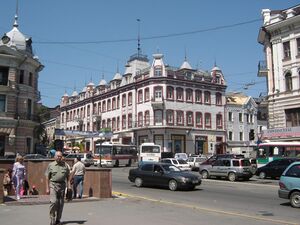
Vladivostok is the starting point of Ussuri Highway (M60) to Khabarovsk, the easternmost part of Trans-Siberian Highway that goes all the way to Moscow and Saint Petersburg via Novosibirsk. The other main highways go east to Nakhodka and south to Khasan.
النقل الحضري
On June 28, 1908, Vladivostok's first tram line was started along Svetlanskaya Street, running from the railway station on Lugovaya Street.[بحاجة لمصدر] On October 9, 1912, the first wooden carriages manufactured in Belgium entered service. Today, Vladivostok's means of public transportation include trolleybus, bus, tram, train, funicular and ferryboat. The main urban traffic lines are Downtown—Vtoraya Rechka, Downtown—Pervaya Rechka—3ya Rabochaya—Balyayeva, and Downtown—Lugovaya Street.
In 2012, Vladivostok hosted the 24th Summit of the Asia-Pacific Economic Cooperation (APEC) forum. In preparation for the event, the infrastructure of the city was renovated and improved. Two giant cable-stayed bridges were constructed in Vladivostok, namely the Zolotoy Rog Bridge over Golden Horn Bay, and the Russky Bridge from the mainland to Russky Island, where the summit took place. The latter bridge is the longest cable-stayed bridge in the world.
الثقافة
المعارض
The active development of art museums in Vladivostok began in the 1950s. In 1960, the House of Artists was built, in which there were exhibition halls. In 1965, the Primorsky State Art Gallery was separated into a separate institution, and later, on the basis of its collection, the Children's Art Gallery was created. In Soviet times, one of the largest areas for exhibitions in Vladivostok was the exhibition hall of the Primorsky branch of the Union of Artists of Soviet Russia. In 1989 the gallery of contemporary art "Artetage" was opened.[53]
In 1995, the Arka gallery of contemporary art was opened, the first exposition of which consisted of 100 paintings donated by the collector Alexander Glezer.[54] The gallery participates in international exhibitions and fairs. In 2005, a non-commercial private gallery "Roytau" appeared.[53] In recent years, the centers of contemporary art "Salt" (created on the basis of the FEFU art museum) and "Zarya",[55][56] have been active.
الموسيقى والأوپرا والباليه
The city is home to the Vladivostok Pops Orchestra.
Russian rock band Mumiy Troll hails from Vladivostok and frequently puts on shows there. In addition, the city hosted the "VladiROCKstok" International Music Festival in September 1996. Hosted by the mayor and governor, and organized by two young American expatriates, the festival drew nearly 10,000 people and top-tier musical acts from St. Petersburg (Akvarium and DDT) and Seattle (Supersuckers, Goodness), as well as several leading local bands.[بحاجة لمصدر]
Nowadays there is another annual music festival in Vladivostok, Vladivostok Rocks International Music Festival and Conference (V-ROX). Vladivostok Rocks is a three-day open-air city festival and international conference for the music industry and contemporary cultural management. It offers the opportunity for aspiring artists and producers to gain exposure to new audiences and leading international professionals.[57]
Musical theater in Vladivostok is represented by the Primorsky Regional Philharmonic Society, the largest concert organization in Primorsky Krai. The Philharmonic has organized the Pacific Symphony Orchestra and the Governor's Brass Orchestra. In 2013, the Primorsky Opera and Ballet Theater was opened.[58] On January 1, 2016, it was transformed into a branch of the Mariinsky Theater.[59] The Russian Opera House houses the State Primorsky Opera and Ballet Theater.[60]
المتاحف
The Vladimir K. Arseniev Museum of Far East History, opened in 1890, is the main museum of Primorsky Krai. Besides the main facility, it has three branches in Vladivostok itself (including Arsenyev's Memorial House), and five branches elsewhere in the state.[61] Among the items in the museum's collection are the famous 15th-century Yongning Temple Steles from the lower Amur.
المدن الشقيقة
ڤلاديڤوستوك مدينة شقيقة لكل من:[62]
 أكيتا, اليابان
أكيتا, اليابان بوسان، كوريا الجنوبية
بوسان، كوريا الجنوبية داليان, الصين
داليان, الصين هاكوداته، اليابان
هاكوداته، اليابان Harbin, China
Harbin, China Ho Chi Minh City, Vietnam
Ho Chi Minh City, Vietnam Incheon, South Korea
Incheon, South Korea Juneau, United States
Juneau, United States Kota Kinabalu, Malaysia
Kota Kinabalu, Malaysia Manta, Ecuador
Manta, Ecuador Niigata, Japan
Niigata, Japan Pohang, South Korea
Pohang, South Korea San Diego, United States
San Diego, United States Tacoma, United States
Tacoma, United States Tskhinvali, South Ossetia[63]
Tskhinvali, South Ossetia[63] Vladikavkaz, Russia
Vladikavkaz, Russia Wonsan, North Korea
Wonsan, North Korea Yanbian, China
Yanbian, China
طالع أيضاً
المصادر
- ^ أ ب ت ث خطأ استشهاد: وسم
<ref>غير صحيح؛ لا نص تم توفيره للمراجع المسماةRef130 - ^ Энциклопедия Города России. Moscow: Большая Российская Энциклопедия. 2003. p. 72. ISBN 5-7107-7399-9.
- ^ "Konstantin Shestakov is the new mayor of Vladivostok". vestiprim.com. 2021-08-05.
- ^ "Обвиняемый во взятках мэр Владивостока подал в отставку".
- ^ "Генеральный план Владивостока". Archived from the original on July 10, 2014. Retrieved 2014-07-10.
- ^ [1]
- ^ أ ب خطأ استشهاد: وسم
<ref>غير صحيح؛ لا نص تم توفيره للمراجع المسماةRef862 - ^ "Об исчислении времени". Официальный интернет-портал правовой информации (in Russian). 3 June 2011. Retrieved 19 January 2019.
{{cite web}}: CS1 maint: unrecognized language (link) - ^ Почта России. Информационно-вычислительный центр ОАСУ РПО. (Russian Post). Поиск объектов почтовой связи (Postal Objects Search) (in روسية)
- ^ Ростелеком завершил перевод Владивостока на семизначную нумерацию телефонов (in الروسية). 2011-07-12. Retrieved 2016-11-26.
- ^ Paine, SCM (2003). The Sino-Japanese War of 1894–1895: perceptions, power, and primacy. Cambridge University Press. ISBN 978-0-521-81714-1.
- ^ Екатерина Века (February 7, 2018). "Владивосток вошёл в топ-5 самых популярных у туристов городов России". Администрация Приморского края. Retrieved October 8, 2020.
- ^ Alexander Jacoby (July 5, 2005). "Eastern Europe in the Far East". The Japan Times. Retrieved October 11, 2020.
- ^ Alex Nosal. "Vladivostok, Europe in Middle of The Orient". The Seoul Times. Retrieved October 11, 2020.
- ^ В. В. Постников. (V. V. Postinkov.) "К осмыслению названия 'Владивосток': историко-политические образы Тихоокеанской России." ("To the comprehension of the name "Vladivostok": historical and political images of the Pacific Russia.") Ойкумена. (Ojkumena.) Vol. 4. July 2010. p. 75. (بالروسية)
- ^ “海参崴来自满语,意为‘海边的小渔村’”:阳, 曹. "冰雪黑龙江 圣诞异国游--频道风采". 天津广播网. 天津人民广播电台交通广播. Archived from the original on September 10, 2017. Retrieved 9 February 2018.
- ^ "Владивосток все же стал Хайшенвеем". Novostivl.ru. 7 May 2010. Retrieved 20 June 2017. (بالروسية)
- ^ 李權鎬. (Lee Kwonho.) 中共對韓半島外交政策: 從辯證法的角度研究. (Mainland China's foreign policy in the Korean Peninsula: a dialectical analysis.) 2001. Retrieved 20 June 2017. (صينية)
- ^ 公开地图内容表示若干规定.
- ^ Narangoa 2014, p. 300.
- ^ Joana Breidenbach (2005). Pál Nyíri, Joana Breidenbach (ed.). China inside out: contemporary Chinese nationalism and transnationalism (illustrated ed.). Central European University Press. p. 89. ISBN 963-7326-14-6. Retrieved 18 March 2012.
Probably the first clash between the Russians and Chinese occurred in 1868. It was called the Manza War, Manzovskaia voina. "Manzy" was the Russian name for the Chinese population in those years. In 1868, the local Russian government decided to close down goldfields near Vladivostok, in the Gulf of Peter the Great, where 1,000 Chinese were employed. The Chinese decided that they did not want to go back, and resisted. The first clash occurred when the Chinese were removed from Askold Island,
- ^ Joana Breidenbach (2005). Pál Nyíri, Joana Breidenbach (ed.). China inside out: contemporary Chinese nationalism and transnationalism (illustrated ed.). Central European University Press. p. 90. ISBN 963-7326-14-6. Retrieved 18 March 2012.
in the Gulf of Peter the Great. They organized themselves and raided three Russian villages and two military posts. For the first time, this attempt to drive the Chinese out was unsuccessful.
- ^ "The Russian train experience". Retrieved 2014-02-21.
- ^ أ ب ت ث Ясько Т. Н. "Сибирская военная флотилия в 1917—1922 гг". fegi.ru. Retrieved September 15, 2020.
- ^ Дежурный по Редакции (November 29, 2015). "Архангельский и Владивостокский порты в годы Первой мировой войны". Ministry of Defense of the Russian Federation. Archived from the original on June 10, 2016. Retrieved September 15, 2020.
- ^ PRECLÍK, Vratislav. Masaryk a legie (Masaryk and legions), váz. kniha, 219 str., vydalo nakladatelství Paris Karviná, Žižkova 2379 (734 01 Karviná) ve spolupráci s Masarykovým demokratickým hnutím (Masaryk Democratic Movement, Prague), 2019, ISBN 978-80-87173-47-3, pages 38 – 50, 52 – 102, 124 – 128,140 – 148,184 – 190
- ^ Joana Breidenbach (2005). Pál Nyíri, Joana Breidenbach (ed.). China inside out: contemporary Chinese nationalism and transnationalism (illustrated ed.). Central European University Press. p. 90. ISBN 963-7326-14-6. Retrieved September 15, 2020.
Then there occurred another story which has become traumatic, this one for the Russian nationalist psyche. At the end of the year 1918, after the Russian Revolution, the Chinese merchants in the Russian Far East demanded the Chinese government to send troops for their protection, and Chinese troops were sent to Vladivostok to protect the Chinese community: about 1,600 soldiers and 700 support personnel.
- ^ Владимир Гелаев. (April 6, 2015). "Новороссия Дальнего Востока". Gazeta.Ru. Retrieved September 15, 2020.
- ^ خطأ استشهاد: وسم
<ref>غير صحيح؛ لا نص تم توفيره للمراجع المسماةhistory1 - ^ أ ب "Планировка и застройка Владивостока в 1923—1931 гг". CyberLeninka. 2008. Retrieved September 15, 2020.
- ^ أ ب ت Ковалёва З. А., Плохих С. В. (2002). "История Дальнего Востока России" (PDF). Retrieved September 15, 2020.
- ^ Кривенко С. "Владивостокский ИТЛ". Система исправительно-трудовых лагерей в СССР. Retrieved September 15, 2020.
- ^ Галина Ткачева (October 10, 2019). "Великая Отечественная во Владивостоке: как и чем жил город в военное время". PrimaMedia.ru. Retrieved September 15, 2020.
- ^ "Владивостокские порты". Камчатский научный центр. Retrieved September 15, 2020.
- ^ أ ب Виктория Антошина (October 12, 2015). "Закрытый на 40 лет Владивосток: штамп "ЗП" в паспорте, фарцовка и фальшивые портовики". PrimaMedia.ru. Retrieved September 15, 2020.
- ^ أ ب ت ث Власов С. А. (2010). "Владивосток в годы хрущевской "оттепели"" (PDF). Retrieved September 15, 2020.
- ^ Александр Львович Ткачев (April 27, 2011). "Первый визит президента США / First Visit of an American President". alltopprim.ru. Retrieved September 15, 2020.
- ^ "УКАЗ Президента РСФСР от 20.09.1991 N 123 "ОБ ОТКРЫТИИ Г. ВЛАДИВОСТОКА ДЛЯ ПОСЕЩЕНИЯ ИНОСТРАННЫМИ ГРАЖДАНАМИ"". kremlin.ru. Archived from the original on December 20, 2014. Retrieved September 15, 2020.
- ^ Levy, Clifford J. "Crisis or Not, Russia Will Build a Bridge in the East," The New York Times. 20 April 2009.
- ^ "Putin proposes Russky Island venue for APEC-2012". Vladivostok: Vladivostok News. يناير 31, 2007. Archived from the original on فبراير 15, 2009. Retrieved فبراير 11, 2009.
- ^ Williamson, Gail M.; Christie, Juliette (2012-09-18). Lopez, Shane J; Snyder, C.R (eds.). "Aging Well in the 21st Century: Challenges and Opportunities". Oxford Handbooks Online: 164–170. doi:10.1093/oxfordhb/9780195187243.013.0015. ISBN 9780195187243.
- ^ "Путин перенес столицу Дальневосточного федерального округа во Владивосток". meduza.io. Retrieved 2018-12-13.
- ^ "Pogoda.ru.net" (in Russian). Retrieved September 8 2007.
{{cite web}}: Check date values in:|accessdate=(help); Unknown parameter|dateformat=ignored (help)CS1 maint: unrecognized language (link) - ^ Russian Federal State Statistics Service (2011). "Всероссийская перепись населения 2010 года. Том 1". Всероссийская перепись населения 2010 года (2010 All-Russia Population Census) (in Russian). Federal State Statistics Service. Retrieved June 29, 2012.
{{cite web}}: Invalid|ref=harv(help); Unknown parameter|trans_title=ignored (|trans-title=suggested) (help)CS1 maint: unrecognized language (link) - ^ خطأ استشهاد: وسم
<ref>غير صحيح؛ لا نص تم توفيره للمراجع المسماة2002Census - ^ Demoscope Weekly (1989). "Всесоюзная перепись населения 1989 г. Численность наличного населения союзных и автономных республик, автономных областей и округов, краёв, областей, районов, городских поселений и сёл-райцентров". Всесоюзная перепись населения 1989 года[All-Union Population Census of 1989] (in Russian). Институт демографии Национального исследовательского университета: Высшая школа экономики [Institute of Demography at the National Research University: Higher School of Economics]. Retrieved August 9, 2014.
{{cite web}}: Invalid|ref=harv(help); Unknown parameter|trans_title=ignored (|trans-title=suggested) (help)CS1 maint: unrecognized language (link) - ^ "Город Владивосток". Города России.
- ^ أ ب "Putin Is Turning Vladivostok into Russia's Pacific Capital" (PDF). Russia Analytical Digest. Institute of History, University of Basel, Basel, Switzerland (82): 9–12. يوليو 12, 2010. Archived from the original (PDF) on يوليو 6, 2011.
- ^ أ ب Oliphant, Roland (2010). "Ruler of the East: The City of Vladivostok Is a Mixture of Promise and Neglect". Russia Profile.
- ^ "Морской порт Владивосток". pma.ru. Archived from the original on August 7, 2016. Retrieved October 12, 2020.
- ^ "Грузооборот морских портов России за январь-декабрь 2016 г." morport.com. Retrieved October 12, 2020.
- ^ أ ب "Исследование и анализ торговых ограничений внешней торговли в городе Владивосток". CyberLeninka. 2015. Retrieved October 12, 2020.
- ^ أ ب "Развитие сети художественных музеев в Приморском крае". 2008. Retrieved October 13, 2020.
- ^ "События в мире в 1995 году". history.xsp.ru. Retrieved October 13, 2020.
- ^ Василий Алленов (March 3, 2016). ""Соль" современного искусства". Novaya Gazeta. Retrieved October 13, 2020.
- ^ "Центр современного искусства открылся на фабрике "Заря" во Владивостоке". PrimaMedia.ru. Retrieved October 13, 2020.
- ^ Ryzik, Melena (28 August 2013). "East by Far East: Vladivostok Rocks". The New York Times.
- ^ "Семь фестивалей, 14 оперных и балетных спектаклей — два года Приморского оперного театра". PrimaMedia.ru. October 19, 2015. Retrieved October 13, 2020.
- ^ "Приморский филиал Мариинского театра". Archived from the original on March 15, 2016. Retrieved October 13, 2020.
- ^ Starrs. "Russian Opera house".
- ^ "Музей истории Дальнего Востока имени В.К. Арсеньева". Приморский музей имени Арсеньева. July 6, 2018. Archived from the original on January 21, 2012.
- ^ "Города-побратимы". vlc.ru (in الروسية). Vladivostok. Retrieved 2021-05-07.
- ^ Сообщение пресс-службы Министерства иностранных дел Республики Южная Осетия (Press release of the Ministry of Foreign Affairs of the Republic of South Ossetia), South Ossetian Ministry of Foreign Affairs 12 May 2021.
- Trofimov, Vladimir et al., 1992, Old Vladivostok. Utro Rossii Vladivostok, ISBN 5-87080-004-8
- Poznyak, Tatyana Z. 2004. Foreign Citizens in the Cities of the Russian Far East (the second half of the XIX — XX centuries). Vladivostok: Dalnauka, 2004. 316 p. (ISBN 5-8044-0461-X).
- Stephan, John. 1994. The Far East a History. Stanford: Stanford University Press, 1994. 481 p.
وصلات خارجية
| Vladivostok
]].- Vladivostok Map (IE 5.0+)
- Siberian Expedition website, by Benjamin Isitt
- Katauri Interactive
- Pages using gadget WikiMiniAtlas
- Articles with روسية-language sources (ru)
- CS1 uses الروسية-language script (ru)
- CS1 الروسية-language sources (ru)
- CS1 errors: unsupported parameter
- Short description is different from Wikidata
- Infobox mapframe without OSM relation ID on Wikidata
- Coordinates on Wikidata
- Pages using infobox settlement with image map1 but not image map
- Articles containing روسية-language text
- Articles containing إنگليزية-language text
- Pages using Lang-xx templates
- Articles with hatnote templates targeting a nonexistent page
- Articles containing صينية-language text
- Articles containing Manchu-language text
- Articles containing Japanese language text
- مقالات فيها عبارات متقادمة منذ 2016
- جميع المقالات التي فيها عبارات متقادمة
- Articles with unsourced statements from September 2013
- Articles with unsourced statements from March 2008
- ڤلاديڤوستوك
- مستوطنات ساحلية
- منشوريا
- قواعد بحرية روسية وسوڤيتية
- موانئ روسيا
- مستوطنات تأسست في 1860
- موانئ الساحل الهادي الروسي
- جغرافيا شمال شرق آسيا
- صفحات مع الخرائط
